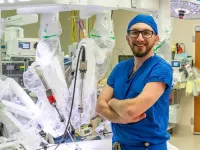(Press-News.org) A microbe found in the lower part of the gut that is associated with good health has been comprehensively analysed and found to have a focused diet breaking down sugars locked away in mucus..
The new study, published in Nature Microbiology today (Friday 31 January) is a complete systematic analysis of how the human colonic beneficial microbe, Akkermansia muciniphila (AM) feeds on types of sugar found in the mucus secreted in the digestive system. The study focused on 66 enzymes that the AM microbe uses to break down mucus that is an essential part of the mucus layer that lines the human gastrointestinal tract.
Using mucus taken from a pig model, the team led by Dr Lucy Crouch from the University of Birmingham found that a combination of enzymes from AM were able to completely break down the mucin. This establishes the first comprehensive understanding of the molecular mechanisms behind how any microbe breaks down the O-linked sugars.
Dr Lucy Crouch, Sir Henry Dale Fellow at the University of Birmingham and corresponding author of the study said:
“This is the first time that we have comprehensively seen how microbes break down the food source O-linked sugars in the gut. This is the first time that a set of enzymes has been used to completely break down the glycan part of mucin. These newly characterised enzymes may be used in characterising the different glycans that humans produce, which can be indicative of disease.
“These glycans, and others like them, are receptors for a variety of pathogens and their toxins, such as Shiga toxin. So, if we can modify the glycans, we may be able to change the severity of disease.
“AM proteins and outer membrane extracts of AM have been shown exert positive effects on the host e.g. a positive effect on metabolism. Some of these proteins interact with host receptors to likely suppress an immune response. AM is relatively close the host as it wants the mucus we produce so we probably interact with it in many different ways.
“We know that AM is a hugely important microbe, and levels of the microbe can be a good indicator of overall health. The bacteria are always beneficial for the gut, and lower levels of it are associated with inflammatory diseases and diabetes. AM is hugely sensitive to decreasing levels of fibre in the diet too.”
END
Healthy gut bacteria that feed on sugar analyzed for the first time
Colon-dwelling Akkermansia muciniphila associated with good health feed on mucus
2025-01-31
ELSE PRESS RELEASES FROM THIS DATE:
240-year-old drug could save UK National Health Service £100 million a year treating common heart rhythm disorder
2025-01-31
A 240-year-old drug called digoxin could save the National Health Service (NHS) at least £100 million each year when treating older patients with atrial fibrillation and heart failure. This was compared to usual treatment with a beta-blocker according to a new study from the University of Birmingham, the city where digoxin was first used in 1785.
In a paper published in the journal Heart, researchers conducted an economic analysis on a clinical trial called RATE-AF to look at the differences between two widely used drugs for older patients with a common heart rhythm disorder called atrial fibrillation (AF) and symptoms ...
Detections of poliovirus in sewage samples require enhanced routine and catch-up vaccination and increased surveillance, according to ECDC report
2025-01-31
Between September and December 2024, four countries in the EU/EEA (Finland, Germany, Poland, Spain) and the United Kingdom reported detections of circulating vaccine-derived poliovirus type 2 (cVDPV2) in sewage samples. This is the first time cVDPV2 has been detected in EU/EEA countries from environmental surveillance.
To date, no human polio cases have been reported and the EU/EEA continues to be polio-free, but such findings call for increased vigilance.
Laboratory analyses likely indicate that the virus has been repeatedly introduced from an unknown area where that specific form of the virus is still in circulation. These recent importations may pose a threat to public ...
Scientists unlock ice-repelling secrets of polar bear fur for sustainable anti-freezing solutions
2025-01-31
Polar bear fur’s natural ability to resist ice formation could pave the way for safer, more sustainable solutions to prevent ice buildup across industries such as aviation and renewable energy, according to researchers at the University of Surrey.
An international study published in Science Advances has explored the anti-icing properties of polar bear fur in extreme Arctic conditions, revealing a unique mix of lipids in the fur’s sebum – an oily substance produced by the skin - that drastically reduces ice adhesion. ...
Ear muscle we thought humans didn’t use — except for wiggling our ears — actually activates when people listen hard
2025-01-31
If you can wiggle your ears, you can use muscles that helped our distant ancestors listen closely. These auricular muscles helped change the shape of the pinna, or the shell of the ear, funneling sound to the eardrums. Millions of years ago, our ancestors stopped using them, so humans’ auricular muscles are only vestigial. But now scientists examining the function of these muscles have discovered that they activate when we’re trying to listen to competing sounds.
“There are three large muscles which connect the auricle to the skull and scalp and are important for ear ...
COVID-19 pandemic drove significant rise in patients choosing to leave ERs before medically recommended
2025-01-31
Researchers have long known that patients who leave emergency departments before medically advised use more emergency care services, are more likely to be readmitted to the hospital and face higher costs of care—as well as increased mortality rates.
Until now, however, little has been known about national, multi-year trends, including the impact of the COVID-19 pandemic on this phenomenon.
“In addition, most studies have focused on specific subgroups of patients, such as those with stroke or those with appendicitis who leave after surgery,” said Elena Andreyeva, PhD, a faculty member with the Texas A&M University School of Public ...
Burn grasslands to maintain them: What is good for biodiversity?
2025-01-31
As grasslands get abandoned, controlled burning is discussed as a labor-saving method of keeping forests at bay. A Kobe University research team found that this method results in higher biodiversity and a higher prevalence of endangered plant species in some grasslands compared to others, depending on what soils they grow on.
Humans have been keeping grasslands since millennia by grazing, mowing and controlled burning, all of these are means to keep forests from overgrowing the grasslands. Grazing and mowing are, however, labor intensive and as rural areas become increasingly depopulated, grasslands have been disappearing worldwide. One consequence ...
Ventilation in hospitals could cause viruses to spread further
2025-01-31
Increased use of ventilation and air cleaners, designed to mitigate the spread of viral infections in hospitals, is likely to have unpredictable effects and may cause viral particles to move around more, according to a new study from researchers at UCL and UCLH.
In the study, published in Aerosol Science & Technology, researchers investigated the effect of using built-in mechanical ventilation and portable air cleaners (PACs)1 upon the spread of airborne particles, which are similar to those breathed ...
New study finds high concentrations of plastics in the placentae of infants born prematurely
2025-01-30
UNDER EMBARGO UNTIL: Jan. 30, 2025, 3:30 p.m. MST
Media Contact: Karen Addis, APR, karen@addispr.com, +1 (301) 787-2394
Denver, Colo. ― Microplastics, which are less than 5 millimeters, and nanoplastics, which are invisible to the naked eye, are widespread throughout our environment. Research has shown that exposure to plastics in general is harmful to both the environment and humans.
Now, in a new study to be presented today at the Society for Maternal-Fetal Medicine’s (SMFM) annual meeting, The Pregnancy Meeting™, researchers will unveil findings that suggest that microplastics and nanoplastics have been found ...
New robotic surgical systems revolutionizing patient care
2025-01-30
SALT LAKE CITY— Huntsman Cancer Institute at the University of Utah (the U) proudly announces the addition of two da Vinci 5 robotic surgical systems. This state-of-the-art technology is designed to enhance precision, control, and safety during minimally invasive surgeries, setting a new standard in patient care. These advancements align with Huntsman Cancer Institute’s focus on successfully delivering world-class cancer care through innovative treatments.
“This is a significant leap forward in robotic surgery,” says Brian Mitzman, MD, MS, FACS, FCCP, Huntsman ...
New MSK research a step toward off-the-shelf CAR T cell therapy for cancer
2025-01-30
CAR T cell therapy is one of the most promising new cancer treatments to emerge in recent years. It involves removing a patient’s own immune T cells and engineering them to recognize specific targets on the surface of the cancer cell.
A major limitation of this type of CAR T cell therapy, called autologous therapy, is that the cells are taken from the patient and must be custom-made into a treatment. This requires patients to wait until their cells are modified for infusion — precious time they may not have.
Now research done at Memorial Sloan ...
LAST 30 PRESS RELEASES:
School meals could unlock major gains for human and planetary health
Menopause hormone therapy does not appear to impact dementia risk
Signature patterns of brain activity may help predict recovery from traumatic brain injury
Dresden study uncovers new key mechanism in cancer cells
New species are now being discovered faster than ever before, study suggests
Cannabis-based products show limited short-term benefit for chronic pain, with increased risk of adverse effects
Cannabis products with more THC slightly reduce pain but cause more side effects
Clearing the brain of aging cells could aid epilepsy and reduce seizures
Brain injuries linked with potential risk of suicide, new study finds
New technique lights up where drugs go in the body, cell by cell
New study finds movement of fishing fleets can reveal shifts in marine ecosystems
Embargoed: New evidence points to potential treatment for vascular dementia
Study uncovers disrupted brain balance in alcohol dependence
Working in groups can help Republicans and Democrats agree on controversial content moderation online
Structural findings reveal how distinct GPCR ligands create different levels of activation
Anything-goes “anyons” may be at the root of surprising quantum experiments
UC review: Maximizing workplace opportunity for veterans
From generation to complex control: Metasurfaces make perfect vortex beams "within reach"
Thin-film lithium niobate-based detector: recent advances and perspectives
Exploring why some people may tend to persistently make bad choices
How cells balance their protein levels
Nirsevimab vs RSVpreF vaccine for RSV–related hospitalization in newborns
Effectiveness and impact of maternal RSV immunization and nirsevimab on medically attended RSV in US children
AI gives scientists a boost, but at the cost of too many mediocre papers
Next-generation vision model maps tree growth at sub-meter precision
Genes aren’t destiny for inherited blindness, study shows
MIT study: High-fat diets make liver cells more likely to become cancerous
Exposure to multiple fine particulate matter components and incident depression in the US Medicare population
Risk of burdensome health care spending over time in the US
Nirsevimab against hospitalizations and emergency department visits for lower respiratory tract infection in infants
[Press-News.org] Healthy gut bacteria that feed on sugar analyzed for the first timeColon-dwelling Akkermansia muciniphila associated with good health feed on mucus

